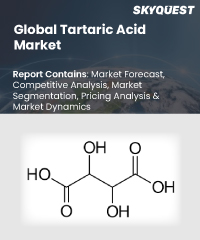
Product ID: SQMIG15E2286

Report ID:
SQMIG15E2286 |
Region:
Global |
Published Date: February, 2024
Pages:
157
|
Tables:
90 |
Figures:
72
Tartaric Acid Market size was valued at USD 351.42 Billion in 2021 and is poised to grow from USD 372.66 billion in 2022 to USD 629.35 billion by 2030, at a CAGR of 6.01% during the forecast period (2023-2030).
Tartaric Acid is becoming popular since Its Advantages make it a valuable ingredient in various industries. Tartaric acid has a variety of applications in various industries such as the food and beverage industry, the pharmaceutical industry, and the cosmetic industry. Tartaric acid is a natural food ingredient that serves as a flavor enhancer and preservative in the food and beverage industry. Its acidic properties make it useful in the production of various food and beverage products. One of the most common uses of tartaric acid is in wine production, where it helps to balance the flavor by giving it a tart taste. It is also added to other beverages like carbonated drinks and fruit juices to improve their flavor and taste. Moreover, tartaric acid acts as a preservative by inhibiting the growth of harmful bacteria, fungi, and yeasts in food products. This property makes it an ideal ingredient for use in bakery and confectionery products such as cakes, bread, and candies. Tartaric acid is also used in the production of some dairy products like sour cream and cheese to help them maintain their texture and taste for a longer period.
In the pharmaceutical industry, tartaric acid is utilized as an excipient for a variety of purposes. One of the most common uses is to adjust the pH of medications, which is necessary for proper drug delivery and absorption. Additionally, it is used to enhance the stability of medications by preventing degradation and extending their shelf life. Furthermore, tartaric acid is employed as a chelating agent, which means it has the ability to bind to metal ions. This property is utilized in pharmaceuticals to improve the bioavailability of certain drugs, such as antibiotics, by allowing them to be better absorbed by the body. This chelating property is also utilized in the production of contrast agents used in medical imaging procedures such as MRI.
Moreover it is used in the metal plating industry, where it is used as a chelating agent to remove metal ions and improve plating quality. In the leather industry, tartaric acid is used in tanning processes to facilitate the binding of tanning agents to the animal hides, thereby improving the quality of the leather produced. Additionally, it is used in the manufacturing of electronics, where it plays a role in the production of semiconductor materials.
US Tartaric Acid Market is poised to grow at a sustainable CAGR for the next forecast year.
Our industry expert will work with you to provide you with customized data in a short amount of time.
REQUEST FREE CUSTOMIZATIONWant to customize this report? This report can be personalized according to your needs. Our analysts and industry experts will work directly with you to understand your requirements and provide you with customized data in a short amount of time. We offer $1000 worth of FREE customization at the time of purchase.

Product ID: SQMIG15E2286